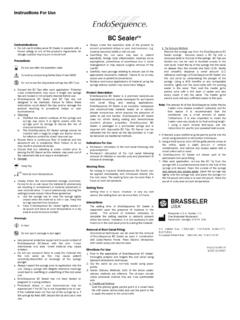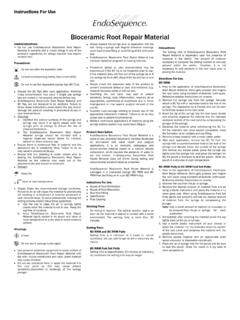Transcription of Safety Data Sheet (SDS) - Brasseler USA
1 P1/10 Issued onRevised on1. IdentificationProductDescriptionOrder codeCompany InformationCompany contact Hazard identificationSignificant hazards and effectsSpecific hazardsGHS classificationPhysical and Chemical hazardsExplosivesFlammable/Ignitable gasFlammable/Ignitable aerosolBurnable/oxidized gasHigh-pressure gasIgnitable liquidFlammable solidAutoreactive chemicalPyrophoric liquidPyrophoric solidSelf-heating chemicalWater-reactive flammable chemicalOxidizing liquidOxidizing solidOrganic peroxideMetal-corrosive chemicalHazards to healthAcute toxicity (oral)Acute toxicity (percutaneous)Acute toxicity (inhalation : gas)Acute toxicity (inhalation : vapor)Acute toxicity (inhalation : dust, mist)Skin corrosivity/IrritationSerious damage to eyes/Eye irritationRespiratory sensitizationSkin sensitizationGermline mutagenicityCarcinogenicity+81(0)289-64- 7277 (QA)+81(0)289-64-3890 (QA)+81(0)289-64-3380 (HQ)+81(0)289-62-5636 (HQ) N/AN/AN/AN/AN/AN/AN/AN/AN/AN/AAspiration hazard : Category 1N/AN/AN/AN/AN/AN/AN/AN/A Recommended use and usage restrictions2015-04-24 Safety data Sheet (SDS)N/AN/AN/ALubrication oilZ016112700 Shimohinata Kamuna-shi Tochigi 322-8666, Japan (HQ)NAKANISHI Assurance (E) on breast-feedingTarget organ/Systemic toxicity (single exposure)Target organ/Systemic toxicity (repeated exposure)Hazards to suction aspirationHazards to environmentHazards to water environment (acute)Hazards to water environment (chronic)Hazards to the Ozone layerLabeling elementsPictogramSignal wordHazard statementsPrecautionary statementPreventionResponseStorageDispos al3.
2 Composition/information on ingredientsSubstance / MixtureSubstanceGeneral product descriptionLubrication oilIngredients and composition4. First-aid measures If symptoms persist, obtain medical contactEye contactIf persistent irritation occurs, obtain medical important symptomsand effects, both acuteand delayedRemove contaminated exposed area with water and follow by washing with soap if availaIf persistent irritation occurs, obtain medical eye with copious quantities of any of the following delayed signs and symptoms appear within thenext 6 hours, transport to the nearest medical facility: fever greaterthan 101 F ( C), shortness of breath, chest congestion orcontinued coughing or precautionary phrasesDangerClassification 1P301+P310: IF SWALLOWED: Immediately call a POISONH304 May be fatal if swallowed and enters airwaysN/AGHS ClassificationAsp. Tox. 1H304If material enters lungs, signs and symptoms may include coughing,choking, wheezing, difficulty in breathing, chest congestion, shortnessof breath, and/or : Dispose of contents/ container to an approved wastedisposal +P331: IF SWALLOWED: Do NOT induce vomitingP405: Store locked upN/AN/AIf swallowed, do not induce vomiting: transport to nearest medicalfacility for additional vomiting occurs spontaneously, keep head below hips to treatment necessary under normal conditions of mineral oil(Liquid paraffin)Chemical nameCAS (another name)(mass %)8042-47-5N/AN/AP3/10 5.
3 Fire-fighting measures 6. Accidental release measures 7. Handling and storageHandling Personal precautions,protective equipment andemergency proceduresLocal authorities should be advised if significant spillages cannot dermatitis signs and symptoms may include a burningsensation and/or a dried/cracked may result in nausea, vomiting and/or local exhaust ventilation if there is risk of inhalation of vapours,mists or combustion products may include:The onset of respiratory symptoms may be delayed for several hoursafter guidance on selection of personal protective equipment seeChapter 8 of this Safety data guidance on disposal of spilled material see Chapter 13 of thisSafety data complex mixture of airborne solid and liquid particulates and gases(smoke).Carbon monoxide may be evolved if incomplete combustion organic and inorganic of first-aidersWhen administering first aid, ensure that you are wearing theappropriate personal protective equipment according to the incident,injury and to physicianUse extinguishing measures that are appropriate to localcircumstances and the surrounding protectiveequipment for firefightersSlippery when spilt.
4 Avoid accidents, clean up from spreading by making a barrier with sand, earth or othercontainment liquid directly or in an up residue with an absorbent such as clay, sand or other suitablematerial and dispose of and materials forcontainment and cleaningupAdditional adviceTreat a doctor or poison control center for , water spray or not use water in a chemical powder, carbon dioxide, sand or earth may be used forsmall fires extinguishing mediSelect firefighters clothing approved to relevant Standards ( : EN 469).General PrecautionsAvoid contact with skin and appropriate containment to avoid environmental from spreading or entering drains, ditches or rivers by usingsand, earth, or other appropriate extinguishingmethodsSpecific hazards duringfirefightingUnsuitable extinguishingmediaProper protective equipment including chemical resistant gloves are tobe worn; chemical resistant suit is indicated if large contact with spilledproduct is Breathing Apparatus must be worn when approachinga fire in a confined Storage 8.
5 Exposure controls/personal protectionComponents with workplace control parametersWhen handling product in drums, Safety footwear should be worn andproper handling equipment should be oxidising material has the potential to be a static grounding and bonding procedures should be used during allbulk transfer dispose of any contaminated rags or cleaning materials inorder to prevent parameters/ PermissibleconcentrationCAS container tightly closed and in a cool, well-ventilated properly labeled and closable at ambient material: For containers or container linings, use mild steel orhigh density Institute of Occupational Safety and Health (NIOSH), USA: Manual of Analytical MethodsNot Assigned5 mg/m3 Use the information in this data Sheet as input to a risk assessment oflocal circumstances to help determine appropriate controls for safehandling, storage and disposal of this prolonged or repeated contact with inhaling vapour and/or and Safety Executive (HSE), UK: Methods for the Determination of Hazardous f r Arbeitsschutz Deutschen Gesetzlichen Unfallversicherung (IFA) , material: containers should not be exposed to high temperaturesbecause of possible risk of mist, mineralTWA(inhalable fraction)ConditionsPackaging materialContainer AdviceComponentValue type(Form of exposure)BasisUS.
6 ACGIHT hreshold LimitValuesMonitoring MethodsNo biological limit on safe handlingAvoidance of contactProduct Safety and Health Administration (OSHA), USA: Sampling and Analytical MethodsFurther national methods may be of sources of recommended exposure measurement methods are given below or contactthe occupational exposure limitsMonitoring of the concentration of substances in the breathing zone of workers or in the generalworkplace may be required to confirm compliance with an OEL and adequacy of exposure some substances biological monitoring may also be exposure measurement methods should be applied by a competent person and samplesanalysed by an accredited After using gloves, hands should be washed and dried of a non-perfumed moisturizer is must only be worn on clean protection RemarksWhere hand contact with the product may occur the use of glovesapproved to relevant standards ( Europe: EN374, US: F739) madefrom the following materials may provide suitable chemical , neoprene or nitrile rubber gloves Suitability and durability of aglove is dependent on usage, frequency and duration of contact,chemical resistance of glove material, hygiene is a key element of effective hand gloves should be down system prior to equipment break-in or drain downs in sealed storage pending disposal or observe good personal hygiene measures, such as washinghands after handling the material and before eating, drinking, and/orRoutinely wash work clothing and protective equipment to contaminated clothing and footwear that cannot be with respiratory protective equipment air-filtering respirators are suitable, select an appropriatecombination of mask and seek advice from glove a filter suitable for the combination of organic gases andvapours [Type A/Type P boiling point >65 C (149 F)].
7 Respiratory protectionNo respiratory protection is ordinarily required under normal conditionsof accordance with good industrial hygiene practices, precautionsshould be taken to avoid breathing of engineering controls do not maintain airborne concentrations to alevel which is adequate to protect worker health, select respiratoryprotection equipment suitable for the specific conditions of use andmeeting relevant protective equipmentProtective measuresPersonal protective equipment (PPE) should meet recommended national standards. Check with Engineering measuresThe level of protection and types of controls necessary will varydepending upon potential exposure controls based on a risk assessment of local measures include:Adequate ventilation to control airborne material is heated, sprayed or mist formed, there is greaterpotential for airborne concentrations to be Information:Define procedures for safe handling and maintenance of and train workers in the hazards and control measuresrelevant to normal activities associated with this appropriate selection, testing and maintenance of equipmentused to control exposure, personal protective equipment, localexhaust good 'Institut National de Recherche et de Securit , (INRS), France exposure controls9.
8 Physical and chemical properties < Pa (20 C / 68 F)estimated value(s)850 g/cm3 ( C / F)Method: ISO 12185 Flash pointDensitySolubility(ies)Vapour pressureRelative vapour densityInitial boiling point andboilingEvaporation rateData not availableFlammability (solid, gas) data not availableUpper explosion limitTypical 10 %(V)Lower explosion limitTypical 1 %(V)> 280 C / 536 Festimated value(s)180 C / 356 FMethod: ISO 2592 AppearanceLiquid at room hydrocarbonData not availableNot applicable-12 C / 10 FMethod: ISO 3016negligibleColourOdourOdour ThresholdpHpour pointWater solubility> 1estimated value(s)Relative (15 C / 59 F)Solubility in other solventsData not availableGeneral adviceAvoid contamination of the environment by following advice given inChapter necessary, prevent undissolved material from being discharged towaste water should be treated in a municipal or industrial waste watertreatment plant before discharge to surface guidelines on emission limits for volatile substances must beobserved for the discharge of exhaust air containing continuous contact we recommend gloves with breakthrough timeof more than 240 minutes with preference for > 480 minutes wheresuitable gloves can be is good practice to wear chemical resistant applicableTake appropriate measures to fulfill the requirements of relevantenvironmental protection short-term/splash protection we recommend the same.
9 Butrecognize that suitable gloves offering this level of protection may notbe available and in this case a lower breakthrough time maybeacceptable so long as appropriate maintenance and replacementregimes are thickness is not a good predictor of glove resistance to achemical as it is dependent on the exact composition of the gloveGlove thickness should be typically greater than mm dependingon the glove make and material is handled such that it could be splashed into eyes,protective eyewear is protection is not ordinarily required beyond standard work protectionSkin and body protectionThermal hazardsP7/10 10. Stability and reactivity 11. Toxicological information Basis for assessmentSymptoms ofOverexposureProduct:Product:Remarks: Not irritating to skin. Prolonged/repeated contact may causedefatting of the skin which can lead to cell mutagenicityRemarks: Not expected to be a skin or skinsensitisationRemarks: Expected to be slightly :Serious eye damage/eyeAuto-ignition temperature> 320 C / 608 FPartition coefficient:noctanol/ConductivityThis material is not expected to be a static given is based on data on the components and thetoxicology of similar of hazardousreactionsHazardous decompositionproductsHazardous decomposition products are not expected to form duringnormal temperatureChemical stabilityConditions to avoidIncompatible with strong oxidising of temperature and direct mm2/s (100 C / 212 F)Method: ISO 301415 mm2/s ( C / F)Method: ISO 3014 Viscosity, dynamicViscosity, kinematicData not availableStrong oxidising not availableViscosityPow: > 6(based on information on similar products)Product.
10 Ingestion may result in nausea, vomiting and/or oral toxicityIf material enters lungs, signs and symptoms may include coughing,choking, wheezing, difficulty in breathing, chest congestion, shortnessof breath, and/or onset of respiratory symptoms may be delayed for several hoursafter dermatitis signs and symptoms may include a burningsensation and/or a dried/cracked rat: > 5,000 mg/kgRemarks: Expected to be of low toxicity:Remarks: Aspiration into the lungs may cause chemical pneumonitiswhich can be toxicityExposure time: 4 hRemarks: Low toxicity by Rabbit: > 5,000 mg/kgRemarks: Low toxicity:LC 50 Rat: > 5 mg/lSkin corrosion/irritationAcute dermal toxicityAcute inhalation toxicityP8/10 12. Ecological information Remarks: Expected to be inherently potentialPersistence anddegradabilityRemarks: Expected to be practically non toxic:LL/EL/IL50 > 100 mg/lProduct:BiodegradabilityToxicity to crustacean(Acute toxicity)Remarks: Expected to be practically non toxic:LL/EL/IL50 > 100 mg/lToxicity to algae/aquaticplants (Acute toxicity)Remarks: Expected to be practically non toxic:LL/EL/IL50 > 100 mg/lToxicity to fish (Chronictoxicity)Toxicity to crustacean(Chronic toxicity)Toxicity tomicroorganisms (Acutetoxicity)Remarks: NOEC/NOEL expected to be > 10 - <= 100 mg/lRemarks: NOEC/NOEL expected to be > 10 - <= 100 mg/lProduct:Remarks: Slightly irritating to respiratory : Not expected to be a : Not expected to impair fertility.








